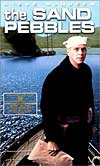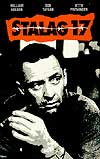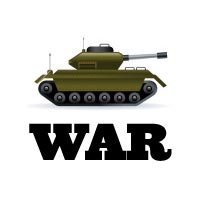Korean War Films:
 In
the 1950s, the Korean War in Northeast Asia served as inspiring content for
only a few Hollywood films, including two anti-war films by Samuel Fuller
about the madness of war: Fixed Bayonets (1951) and The Steel Helmet
(1951). One of the best films about the Korean War was director Joseph
H. Lewis' Retreat, Hell (1952), portraying the US Marine Corps' valiant
withdrawal from the Changjin Reservoir, with Frank Lovejoy as the Marine Battalion
Commander. In Mark Robson's The Bridges at Toko-Ri (1954), based on
James Michener's novel, William Holden played the role of a war-weary Lieutenant
- a family man recalled from the Naval Reserve to fly a possibly-fateful bombing
mission over Communist-protected bridges in Korea. Lewis Milestone's anti-war
masterpiece Pork Chop Hill (1959) starred Gregory Peck as an Army Lieutenant
of a platoon (King Company) in a no-win situation - commanded to assault a
tactically-unimportant, but well-guarded hill held by the N. Koreans and Chinese
Communists in the final days of the war. [Milestone had two previous anti-war
films for each of the World Wars, All Quiet on the Western Front (1930) and A Walk in the Sun (1946).]
Peck also starred as the rebel general in Joseph Sargent's war drama MacArthur
(1977), told in flashback, including his promise at Corregidor in 1942
("I shall return"), and his firing by President Truman for defying
orders during the Korean conflict. John Frankenheimer's chilling The
Manchurian Candidate (1962) brilliantly examined the fearful, sinister
consequences of Korean War brainwashing, with Laurence Harvey as Raymond Shaw
- a military hero programmed to assassinate, and his power-hungry, manipulative
mother Angela Lansbury. In
the 1950s, the Korean War in Northeast Asia served as inspiring content for
only a few Hollywood films, including two anti-war films by Samuel Fuller
about the madness of war: Fixed Bayonets (1951) and The Steel Helmet
(1951). One of the best films about the Korean War was director Joseph
H. Lewis' Retreat, Hell (1952), portraying the US Marine Corps' valiant
withdrawal from the Changjin Reservoir, with Frank Lovejoy as the Marine Battalion
Commander. In Mark Robson's The Bridges at Toko-Ri (1954), based on
James Michener's novel, William Holden played the role of a war-weary Lieutenant
- a family man recalled from the Naval Reserve to fly a possibly-fateful bombing
mission over Communist-protected bridges in Korea. Lewis Milestone's anti-war
masterpiece Pork Chop Hill (1959) starred Gregory Peck as an Army Lieutenant
of a platoon (King Company) in a no-win situation - commanded to assault a
tactically-unimportant, but well-guarded hill held by the N. Koreans and Chinese
Communists in the final days of the war. [Milestone had two previous anti-war
films for each of the World Wars, All Quiet on the Western Front (1930) and A Walk in the Sun (1946).]
Peck also starred as the rebel general in Joseph Sargent's war drama MacArthur
(1977), told in flashback, including his promise at Corregidor in 1942
("I shall return"), and his firing by President Truman for defying
orders during the Korean conflict. John Frankenheimer's chilling The
Manchurian Candidate (1962) brilliantly examined the fearful, sinister
consequences of Korean War brainwashing, with Laurence Harvey as Raymond Shaw
- a military hero programmed to assassinate, and his power-hungry, manipulative
mother Angela Lansbury.
 Years
later, iconoclastic Robert Altman's anti-Korean war, off-beat dark-comedy M*A*S*H (1970), with its ballad 'Suicide is Painless,' was an
outrageous satirization about a group of surgeons and nurses stationed at
a Mobile Army Surgical Hospital (MASH) along the Korean 38th parallel. The
army surgeons retained their sanity by joking, anti-authoritarian and anti-bureaucratic
sentiment, and pranks. Although the film was set in Korea, its real focus
of attention was the frustrating Vietnam conflict. Only Burghoff of the superb
cast (Elliott Gould, Donald Sutherland, Oscar-nominated Sally Kellerman, Robert
Duvall and Gary Burghoff) went on to reprise his role as Radar in the popular,
long-running TV series. Years
later, iconoclastic Robert Altman's anti-Korean war, off-beat dark-comedy M*A*S*H (1970), with its ballad 'Suicide is Painless,' was an
outrageous satirization about a group of surgeons and nurses stationed at
a Mobile Army Surgical Hospital (MASH) along the Korean 38th parallel. The
army surgeons retained their sanity by joking, anti-authoritarian and anti-bureaucratic
sentiment, and pranks. Although the film was set in Korea, its real focus
of attention was the frustrating Vietnam conflict. Only Burghoff of the superb
cast (Elliott Gould, Donald Sutherland, Oscar-nominated Sally Kellerman, Robert
Duvall and Gary Burghoff) went on to reprise his role as Radar in the popular,
long-running TV series.
Other 50s and 60s War Films:
Most war films in the 1950s ignored the Korean conflict, however,
and instead looked back at both earlier world wars with films mixing entertainment,
history, and drama. Top stars Humphrey Bogart (in an Oscar-winning performance
as a cynical, alcoholic boat owner) and Katharine Hepburn (as a stubborn,
indomitable spinster missionary) starred together in John Huston's exciting
World War I adventure film The African Queen (1951), shot on location in Africa. Together,
as representatives of the American and British positions, they confronted
the Germans on the geographical margins of the major conflict. Graham Greene's
1955 novel was twice adapted for the screen: first by director/writer Joseph
L. Mankiewicz as The Quiet American (1958) starring Audie Murphy, featuring
a love triangle set amidst political turmoil in 1952 Saigon around the time
of the end of the First Indochina War, and second by Phillip Noyce as a more
faithful remake - The Quiet American (2002), with Oscar-nominated Michael
Caine.
Director Edward Dmytryk's The Caine
Mutiny (1954), another film with Bogart and an adaptation of the Pulitzer
Prize-winning Herman Wouk novel, told the story of shipboard conflict and
a mutiny aboard a WWII naval vessel (USS Caine), and the subsequent
court-martial trial of the paranoid ship's captain. Billy Wilder's Stalag
17 (1952) examined a group of G.I.s (including Best Actor-winning William
Holden) who were thrown together in the notorious German WWII prison camp, Stalag 17. Guy Hamilton's The Battle of Britain (1969), with
Michael Caine, Christopher Plummer and Robert Shaw as RAF pilots, accurately
captured how valiant the British were 'under fire' during the many air battles
and bombing raids of the German Luftwaffe in the summer and autumn of 1940.
The true, gripping espionage tale The Man Who Never Was (1955) told
of how British intelligence agents fooled the Nazis with fake invasion plans
planted on an Allied corpse. Stanley Kramer's chilling On the Beach (1959) dramatized the results of global nuclear war for the last survivors in Australia.
 Another
very effective anti-war film of WW I was Stanley Kubrick's Paths Of Glory (1957), a tale of the fate confronting scapegoated,
innocent French soldiers wrongfully brought before a court-martial trial before
their execution. The insanity and absurdity of war was never better told in
its story of corruption in the French High Command, with Kirk Douglas as the
commander of the French regiment stationed along the Western Front. Its WWI
warfare scenes, with technically-brilliant tracking shots in the trenches,
are some of the most realistic ever filmed. [Australian director Bruce Beresford's
courtroom drama Breaker Morant (1980), with English actor Edward Woodward,
told a similar story of three British soldiers in the Boer War at the turn
of the century, as members of the Bushveldt Carboniers, who were scapegoated
and placed on trial for court-martial for shooting POW's.] The UK's historical
epic Zulu (1964) recreated the 1879 Zulu warrior siege of Rorke's Drift,
a South African outpost held by outnumbered British-Welsh soldiers in Natal,
Africa. Another
very effective anti-war film of WW I was Stanley Kubrick's Paths Of Glory (1957), a tale of the fate confronting scapegoated,
innocent French soldiers wrongfully brought before a court-martial trial before
their execution. The insanity and absurdity of war was never better told in
its story of corruption in the French High Command, with Kirk Douglas as the
commander of the French regiment stationed along the Western Front. Its WWI
warfare scenes, with technically-brilliant tracking shots in the trenches,
are some of the most realistic ever filmed. [Australian director Bruce Beresford's
courtroom drama Breaker Morant (1980), with English actor Edward Woodward,
told a similar story of three British soldiers in the Boer War at the turn
of the century, as members of the Bushveldt Carboniers, who were scapegoated
and placed on trial for court-martial for shooting POW's.] The UK's historical
epic Zulu (1964) recreated the 1879 Zulu warrior siege of Rorke's Drift,
a South African outpost held by outnumbered British-Welsh soldiers in Natal,
Africa.
There were two Civil War era war films in the 50s. The confusion
and fear of the wartime experience for a young, recruited Civil War Union
soldier was presented in John Huston's The Red Badge of Courage (1951),
an adaptation of Stephen Crane's 1894 novel, with real-life war hero Audie
Murphy in the anti-heroic lead role. Another Civil War film, John's Ford's The Horse Soldiers (1959) (Ford's only Civil War film), starred John
Wayne as the tough leader of a contingent of Union soldiers, sent on a mission
into Confederate territory in Louisiana to destroy a railroad line and cut
off supplies.
 Director
David Lean's only pure war film was Columbia's The Bridge on the River Kwai (1957), a powerful, award-winning,
widescreen action/drama and perceptive character study. Its main focus was
the 'madness' of war - exemplified by the clash of wills
between two fanatical military leaders: Japanese Col. Saito (Sessue Hayakawa)
and British Col. Nicholson (Alec Guinness), during the 1943 construction by
British POWs of a bridge for the Burma-Siam railway. Robert Wise's The
Sand Pebbles (1966), starred Steve McQueen as a naval machinist's mate
on board a US naval gunboat (captained by Richard Crenna) on the Yangtze River
on the eve of the 1926 Chinese revolution. Its story of tragic warfare and
a failed mission (a veiled and subtle comment upon the Vietnam War) was expressed
by McQueen's final words: "What the hell happened?" Director
David Lean's only pure war film was Columbia's The Bridge on the River Kwai (1957), a powerful, award-winning,
widescreen action/drama and perceptive character study. Its main focus was
the 'madness' of war - exemplified by the clash of wills
between two fanatical military leaders: Japanese Col. Saito (Sessue Hayakawa)
and British Col. Nicholson (Alec Guinness), during the 1943 construction by
British POWs of a bridge for the Burma-Siam railway. Robert Wise's The
Sand Pebbles (1966), starred Steve McQueen as a naval machinist's mate
on board a US naval gunboat (captained by Richard Crenna) on the Yangtze River
on the eve of the 1926 Chinese revolution. Its story of tragic warfare and
a failed mission (a veiled and subtle comment upon the Vietnam War) was expressed
by McQueen's final words: "What the hell happened?"
Black Comedies/War Films:
War films that satirized the insanity of war, known as black
comedies, included:
-
 the
Marx Brothers' classic Duck Soup (1933) the
Marx Brothers' classic Duck Soup (1933)
- Billy Wilder's black comedy/drama Stalag 17 (1953) with Best Actor-winning William Holden, perfectly captured the situation
of U.S. POW soldiers in a Nazi prison camp during WWII [The setting of the
film was later adapted for the TV series Hogan's Heroes]
- Stanley Kubrick's masterful anti-war film of the nuclear
age, Dr. Strangelove or: How I Learned to Stop Worrying and Love the Bomb
(1964), similar to Sidney Lumet's Fail-Safe (1964) about
a computer malfunction that triggers a nuclear war, with Peter Sellers playing
three roles
- Mike Nichols' anti-war satire about the absurdities of
war, Catch-22 (1970), told about a defiant WWII bomber pilot (Alan
Arkin), one of many fliers stationed in the Mediterranean trying to escape
the conflict
- Robert Altman's M*A*S*H (1970), already mentioned
- Ivan Reitman's irreverent military comedy Stripes (1981) focused on the misadventures of unemployed loser Bill Murray as a misfit
volunteer in the Armed Forces
- Robin Williams starred as an irreverent and antagonistic
Air Forces Radio disk jockey who boosted GI morale in Barry Levinson's Good
Morning, Vietnam (1987) with manic commentary and straight-forward news,
but alienated other superior officers
Epic War Films:
 During
the 1960s and 70s, a number of war films returned to WWII as their well-documented
backdrop. They were often fact-based, historical or biographical epics, such
as the following: During
the 1960s and 70s, a number of war films returned to WWII as their well-documented
backdrop. They were often fact-based, historical or biographical epics, such
as the following:
- producer Darryl F. Zanuck's authentic-looking, 3-hour black
and white war epic The Longest Day (1962) (dubbed "Z-Day"
when the producer bailed out the film with his own finances) was about the
Normandy landing on D-Day (June 6, 1944) (restaged in Corsica); this landmark
film was told from four points of view, with four directors (American, English,
French, and German) and in three languages; it required 43 major roles and
23,000 extras
- Ken Annakin's The Battle of the Bulge (1965) portrayed
the Cinerama spectacle of the German's last major stand, with Henry Fonda
and Robert Shaw
- Franklin J. Schaffner's complex biopic Patton
(1970) starred Oscar-winning George C. Scott (who refused the award)
as the legendary, heroically-crazed, and controversial "Old Blood and
Guts" military genius, and Karl Malden as the balanced Gen. Omar Bradley
- the Japanese-American co-produced film Tora! Tora! Tora!
(1970) was about the Pearl Harbor attack told from the perspective of
both sides
- Jack Smight's Midway (1976), told of the surprise
American victory over the Japanese fleet in 1942, with a cast including
Charlton Heston, Henry Fonda, Glenn Ford, and Robert Mitchum
- Roland Joffe's Fat Man and Little Boy (1989) was
about The Manhattan Project which tested and manufactured the devastating
atomic bombs that fell on Hiroshima and Nagasaki
Most of the other war films at this time were all-star World
War II buddy films, typically with large groups of stars bonded together in
exciting, old-fashioned wartime situations. Films in this category included:
- J. Lee Thompson's thrilling adventure film The Guns
of Navarone (1961) starred Gregory Peck heading a guerrilla mission
to destroy a German cave fortress with giant, long-range guns atop a 400
foot cliff on an island in the Aegean Sea
- John Sturges' star-studded POW prison break film The
Great Escape (1963), based on a true story of Allied servicemen during
World War II, with Steve McQueen as the "Cooler King"
- Mark Robson's Von Ryan's Express (1965), with Frank
Sinatra as the head of a group of escaped POWs in Italy
- The Blue Max (1966), with George Peppard in the
starring role as Bruno Stachel, a WWI German bi-plane bomber flier
 Robert
Aldrich's The Dirty Dozen (1967), about a group of a dozen death-row
military convicts (including Telly Savalas, Donald Sutherland, Jim Brown,
John Cassavetes, Charles Bronson, Robert Ryan, George Kennedy and more)
sent on a suicide mission (headed by a tough Lee Marvin) behind Nazi enemy
lines to destroy a French chateau Robert
Aldrich's The Dirty Dozen (1967), about a group of a dozen death-row
military convicts (including Telly Savalas, Donald Sutherland, Jim Brown,
John Cassavetes, Charles Bronson, Robert Ryan, George Kennedy and more)
sent on a suicide mission (headed by a tough Lee Marvin) behind Nazi enemy
lines to destroy a French chateau- Brian G. Hutton's Where Eagles Dare (1969), with
Richard Burton as a secret agent leading a team on a mission to prevent
D-Day
- Hutton's Kelly's Heroes (1970) - an offbeat variation
on The Dirty Dozen, in which Clint Eastwood (as 'Kelly') and a group
of American soldiers decide to steal $16 million of plundered gold bullion
behind Nazi enemy lines during WWII
- Richard Attenborough's big-budget A Bridge Too Far (1977) with an all-star cast, adapted from Cornelius Ryan's epic book, told of
a daring and failed 1944 WWII mission behind enemy lines in Holland to capture
a series of bridges
- Guy Hamilton's Force 10 From Navarone (1978), the
'sequel' to the earlier The Guns of Navarone, with another group
of Allied commandos (including Robert Shaw and Harrison Ford) attempting
to blow up a Nazi bridge in war-torn Yugoslavia
|
